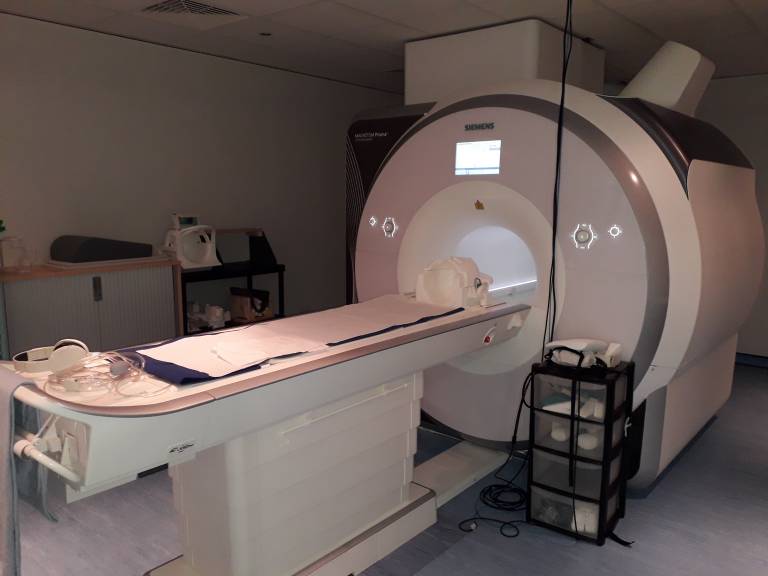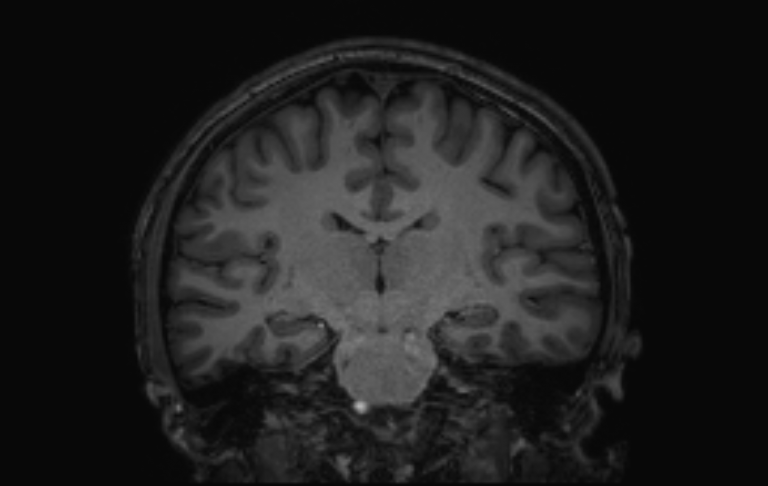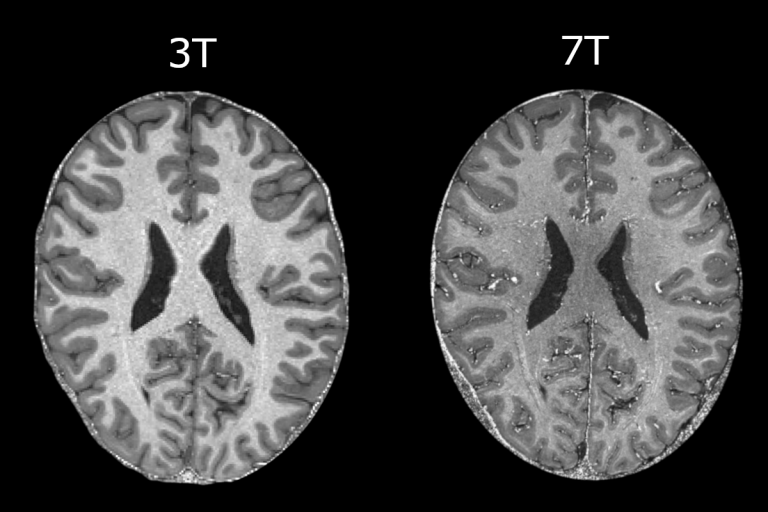What is an MRI Scanner? Magnetic Resonance Imaging (MRI) is a technique which enables us to view the inside of the brain and body. The MRI scanner looks like a tube where the participant lies on a bed in the middle as seen in figure 1. When lying in the scanner, the participant’s head is located within a smaller ‘head coil’ which detects signals, the MRI signals.
How Does an MRI Scanner Work? MRI uses different magnetic fields and radio waves to measure the properties of tissues in your body. Tissues respond to these magnetic fields in different ways which result in varying contrasts in an MR image. For example, looking at the MR image in figure 2 on your right you can see that some parts of the brain are brighter than other parts depending on the tissue type. Because MRI uses only magnetic fields and radio waves, it is considered more safe than scans which use radiation (e.g. x-rays).
What is a 7T Scanner and How Does it Differ from Typical MRI Scanners? When we talk about types of MRI scanners, we refer to the strength of the magnetic field in Tesla (abbreviated by T). Typical MRI scanners have a magnetic field strength of 3 Tesla (3T). 3T MRI scanners are routinely used in clinical imaging. New MRI scanners for ultra-high resolution imaging have a field strength of 7 Tesla (7T), these decrease the relative noise level in the images and allow for scanning with an even higher resolution.
What is Spatial Resolution? Spatial resolution refers to the (effective) size of each pixel in an image. In figure 3 you can see an example of a scan at 3T (left) and one at 7T (right). The picture on the right offers much more detail and smaller structures can be better seen than in the image on the left.
Why Does Spatial Resolution Matter in MRI Scanning? If an MRI scan has a higher resolution, it means we can obtain detailed images of higher quality. This is similar to going from standard TV to high-definition TV. This means we can measure properties of the brain in more detail and potentially pick up subtle signs of Alzheimer's disease that standard MRI scans cannot show. These ultra-high resolution MRI scans may enable us to detect harmful proteins which are involved in dementia without using radioactive injections, or detect effects of the disease never seen before in the living brain.
Is Ultra-High Resolution MRI Safe? A 7T MRI scanner is very similar to lower field MRI scanners. Thus, as with standard MRI strict procedures are followed to ensure the safety of the person being scanned. For example, removing all metal on you (coins, jewelry) and making sure no metal is in your body (pacemakers, stents). Due to the stronger magnetic field, these safety procedures will be slightly more stringent than normal MRI scanners but we and the radiographers will go through them with our participants. In some cases the 7T MRI scanner will be louder than the typical 3T MRI scanner, but we will give our participants appropriate hearing protection to ensure comfort.
Why Does an MRI Scanner Make a Noise? MRI scanners use fast switching magnetic field gradients in the kilo-Hertz frequency range, in order to create images of what is inside our brains and body. The coils generating these fields experience some force in the strong magnetic field, which in turn leads to small vibrations of the system. These vibrations also translate into sound waves, which can be heard. Since the switching of magnetic field gradients depends on the type of MR image acquired, one can typically hear many different sounds over the course of an MRI scan.
What Does an MRI Scanner Sound Like? An MRI scanner sounds like loud beeping and buzzing (similar to electronic dance music). Listen below to example of an MRI scanner. You can hear these MRI noises in the background of this song by clicking this link:
https://www.youtube.com/watch?v=D-ihfLPD6S8
Some physicists have even managed to program an MRI scanner to play music by specifically switching the magnetic field gradients. Click on this link if you want to hear what that sounds like:
 Close
Close




